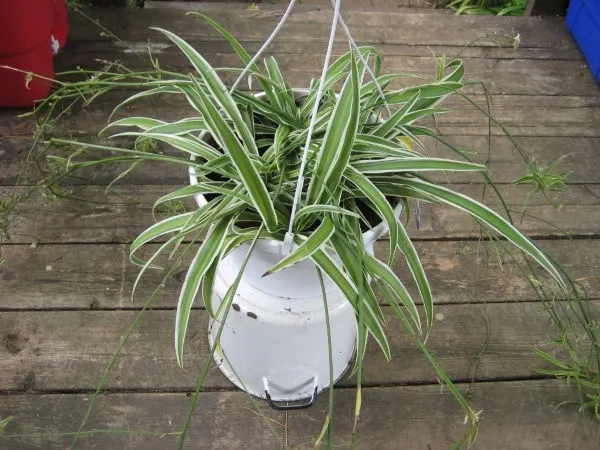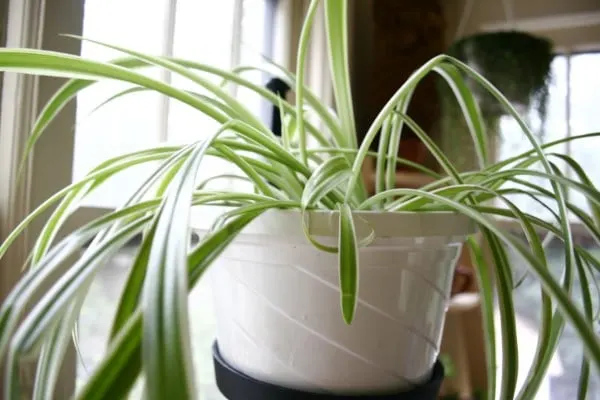The Spider Plant, also called spider ivy, and ribbon plant is an evergreen perennial flowering plant. It is a type of plant native to the tropical regions of Africa. It belongs to the family of plants known as Asparagaceae and order Asparagales. The scientific name of the spider plant is Chlorophytum comosum.
It is a very popular low-maintenance houseplant that can be grown in pots or hanging baskets and survive low-light conditions. The plant has long, narrow leaves with white stripes running down the length of each leaf.
It also has small white flowers that bloom on tall spikes above its leaves during the summer months. This guide will tell you how to prune a spider plant so you can keep it healthy.

Introduction: Why Prune a Spider Plant?
A spider plant is a popular houseplant that can be grown in various ways. It grows best when trimmed and pruned, but many people are unsure how they should do this.
Chlorophytum comosum is often grown as hanging plants, but it can also be grown on a table or windowsill. It grows well in indirect sunlight and requires moist soil with good drainage.
The best time to trim spider plants is usually during the winter months, when the plant slows down and starts to lose its leaves.
Trimming the plant helps keep it from getting too tall or leggy and ensures that all of its leaves get enough light from the sun. Here are the signs that indicate that your spider plant needs trimming.
- It is important to prune your spider plant when you notice spiderlings baby spider plants growing in numbers.
- When the long slender leaves of spider plants outgrow the pot, then it is the time to prune it.
- The presence of brown or yellow leaves on spider plants means they need pruning.
The Key Benefits of Pruning a Spider Plant
Spider plants are popular plants that are easy to grow and maintain. They can also be trained to climb up a trellis, which makes them a perfect plant for the window sill.
You can control its size, shape, and overall appearance with just a few snips. Before going into the detail of how to prune a spider plant, let’s look at the benefits of pruning on it:
- Pruning keeps the plant from becoming too leggy by trimming off any dead parts, i.e., yellow or brown leaves and stems.
- It helps them stay the size you want and stops them from becoming overgrown.
- Pruning spider plants will keep them as compact as possible and help them keep their original form.
- It also offers a process through which they can be rejuvenated and regain much of the lost energy.
- If not pruned for a long-time spider plant will start producing numerous spiderettes, which will use up the plant’s energy. Therefore, you remove these baby spider plants or spiderettes with pruning to keep the plant healthy.
- If you stop giving the plant fertilizer or water, it will not grow well. To make sure it’s, try to remove the spiderettes too.
- Pruning will help to keep the plant away from diseases and infestations.
- It gives the plant sufficient room that allows proper air circulation.
- It gives your plant a manicured and fresh look enhancing the aesthetic appeal of your garden.

5 Ways On How To Prune A Spider Plant
It is important to prune your plants from time to time because they will get too big and take up a lot of space. Do you have a spider plant that’s getting a little too big for its pot? If so, don’t worry. Let’s take a look at how to prune a spider plant.
Things You Need To Prune A Spider Plant
To perform your mini-pinching, make sure that you use sharp, clean and sterilized tools. It’s also good to keep pets and kids away from the plants while pruning them. Clean and disinfect hands and tools before and after each pruning to stop pests or diseases from spreading between plants.
A medium-sized gardening shear; you don’t need to invest in a large pruner due to the average height of the spider plant. A manual pruning shear will be enough.
- A pair of gardening gloves.
- A large sized pot
- Repotting Soil
- It is best to sterilize the tools after each cut. You can do it with the help of chlorine, alcohol, or simply exposing the blades on the flame.
- Make sure the tools are sharp because a dull tool can harm your spider plant.
Here are 5 ways for how to prune a spider plant:
The best time to prune spider plants is in the late fall or winter months, when it’s time for their annual rest period. Let’s start the trick!
1. Repot The Spider Plant
Spider plant needs pruning when it is overgrown, which signifies that it needs a bigger pot. It would be best to report your spider plant in the next size pot before pruning to give it enough room to grow well.
2. Trim The Roots
While repotting, examines your spider plant’s roots. Interestingly, this plant also needs root trimming because it became root bound because of a small-sized pot or overwatering. Dust off the roots to fully examine the foliage base. You can also use a garden spray to clean the roots.
After that, trim the dead roots and overgrown roots with your garden scissors. Root trimming will help the plant grow nicely for a long time without transplantation.
3. Add Fertilizer
Adding fertilizer after root trimming is a good idea before repotting the spider plant. Add some repotting soil and essential fertilizer to the new plant, moisten it, and it is ready to plant your spider plant!
4. Trim Brown And Yellow Leaves
The first step is to trim off any dead leaves around the edges and discard them. Next, use your fingers or sharp shears to cut back long stems as much as possible without hurting new growths or too many leaves from other areas of the plant, starting at the top and working your way down.
Also, avoid the causes that turn your spider plant’s leaves yellow or green. These can be:
- The plant is might exposed to excessive sunlight. It should be receiving indirect sunlight for around 4-6 hours.
- Don’t give water loaded with fluoride or chlorine as both these chemicals can damage your plant.
5. Prune Spider Plant In Spring
Spider plants can grow out of their containers and hangover. If your plant is within the height range of 2 to 3 feet (60 to 90 cm), it is best to prune it yearly. However, you can extend this period if you give a severe prune. Take a gap of at least 2 years for root pruning your spider plant.
Conclusion
We hope you got your answer on how to prune a spider plant. Please share this article with your friends and family if you liked this article. Leave a comment below in case of any garden-related queries. Our garden experts will surely try to help you out.
